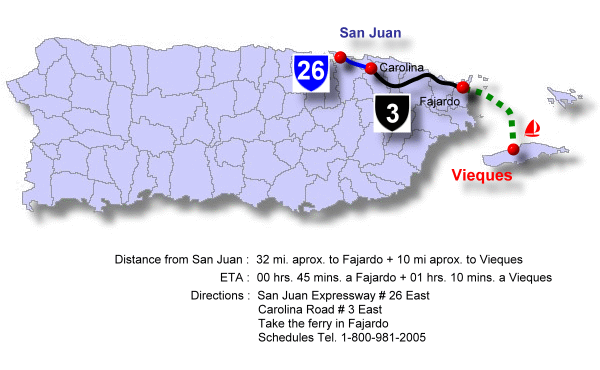
Vieques, Puerto Rico
Baby Island
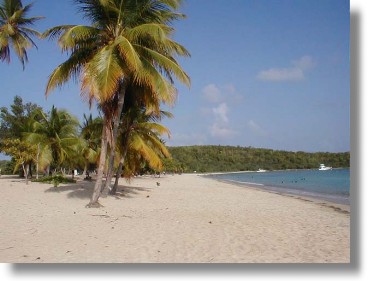 Vieques (vee-AI-kais), baptized the “Baby Island”, or “Little Girl Island”, by poet Luis Llorens Torres, is located 10 kilometers (6 miles) southeast of Puerto Rico. The patron saint festival is held in July in honor of the Virgen del Carmen, the patron saint of Vieques.
Vieques (vee-AI-kais), baptized the “Baby Island”, or “Little Girl Island”, by poet Luis Llorens Torres, is located 10 kilometers (6 miles) southeast of Puerto Rico. The patron saint festival is held in July in honor of the Virgen del Carmen, the patron saint of Vieques.
Vieques is currently in the process of reorienting its economy due to the transfer of lands formerly occupied by the United States Navy to the government of Puerto Rico in May of 2003.
The eastern part of the island is now under the control of the United States Fish and Wildlife Service while various parts of the western zone of the island are under the jurisdiction of the United States Department of the Interior, the municipal government of Vieques and the Puerto Rico Conservation Trust.
Vieques is located 6 miles southeast of Puerto Rico, separated from the main island by the Vieques Passage. Off Vieques’ north coast is the Atlantic Ocean and to the south is the Caribbean Sea. The topography of the island includes hills, small valleys and coastal plains.
Economic activity in Vieques is based on construction, tourism, fishing, and jobs generated by the General Electric factory, which has been on the island for more than two decades. Among its tourism attractions are its beaches and bioluminescent bays.
Foundation:
Vieques, was discovered by Christopher Columbus in his second voyage. SInce 1938 according to a law formulated by the legislature, recognizes November 19th as the day of the discovery for both the “Baby Island” and the “Big Island”. A controversy between some historians exists who believe that Vieques was discovered 3 days (16th) before the Island of Puerto Rico, but it is officially celebrated the 19th as the Day of the Discovery.
The island municipality is located southeast of Puerto Rico between latitudes18.0 and 18.5 north and between longitude 65.34 and 65.16 west. The Atlantic Ocean surrounds it to north and south with the Caribbean Sea. It has an area of 33,088 acres (51.7 square miles) and measures 18 miles in length by 3.5 miles wide in its widest area.
Its average elevation is at sea level about 38 feet although it has some elevations with 400 feet above sea level. Its name, in Indian language means “small land” and it is said that “Bieque” was an Indian Chief. The certain thing is that it appeared for the first time in the maps in 1527 with the name of Vieques.
The first colonizers of the island were: Luis Cherot, Constante Leguillau, Pantaleón Ortiz, Augusto Negrón Longpré, Antonio Villegas, Claudio Easton, Juan Purus, Miguel Figueroa, Guillermo Opio and Daniel Terrible.
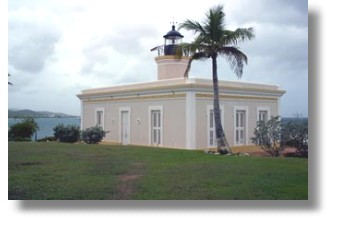
The French were the first Europeans to occupied the island. They were pushed out by the Spaniards in 1647. Years later the English occupied the island and constructed a new fort, but the Puerto Rican privateer Miguel Hernandez removed the English in name of the Spanish Crown in 1718. Helped by an expedition sent by the Governor of Puerto Rico.
Officially, in 1843 the first town was founded, Isabel II in honor to the queen of Spanish. Soon with the impulse that produced the slave force, a series sugar refineries arose that still denominate some of wards of the island. They are Esperanza, Puerto Real, Playa Grande, La Arcadia and Resolución.
In the history and customs of the “Baby Island” three countries have left their roots. Spain bequeath the traditions and the language, England influenced with the colony that still exists and the profile of some of the structures reflects the French influence, names like Le Brum, Lanzó, Dubois, Motineau, Choisne, Monrepose confirm this fact.
Vieques has historical monuments that are visited by thousands of tourists every year:
- El Fuerte (the bunker) constructed in 1845 during the reign of Isabel II.
- La Casa del Francés (Sportsman House). It was the residence of the owner of a sugar cane plantation, Henri Muraille, and was constructed around 1910. Nowadays it is being used as a hotel.
- The Light House was constructed at the end of the XIX century. Its designed is of the neoclassic type and has a cornice around it. It was designed by the Puertorrican José Sanz.
- The tomb of Governor Leguillau, who was the first military governor of Vieques, Mr. Theodore Leguillau.
Location:
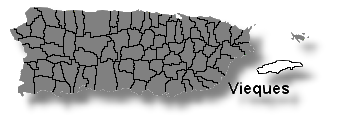 The Island of Vieques is located between Puerto Rico and Saint Thomas, about 6 miles southeast of the coast of Puerto Rico and in front of the coast of Humacao, separated by the Passage of Vieques. It coasts are bathed by the waters of the Atlantic Ocean.
The Island of Vieques is located between Puerto Rico and Saint Thomas, about 6 miles southeast of the coast of Puerto Rico and in front of the coast of Humacao, separated by the Passage of Vieques. It coasts are bathed by the waters of the Atlantic Ocean.
Area:
134.4 sq km / 51.7 sq mi
Population:
9,106 (census 2000)
Population Density:
67.7 per sq km / 176.1 per sq mi
People are known as:
Viequenses
Vieques is also known as:
Isla Nena (Baby Island)
Wards: Vieques, Puero Rico
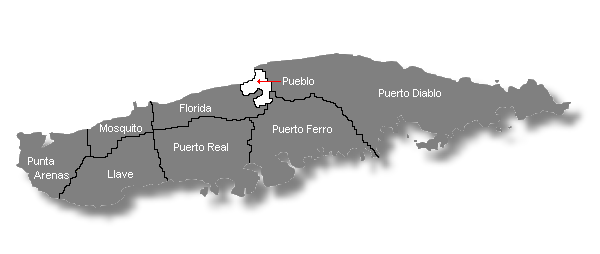
| Population by Wards – Vieques | Habitants |
| Florida | 4,126 |
| Isabel II Pueblo | 1,459 |
| Llave | 8 |
| Mosquito | 0 |
| Puerto Diablo | 984 |
| Puerto Ferro | 856 |
| Puerto Real | 1,673 |
| Punta Arenas | 0 |
| Total | 9,106 |
Source: Censo 2000
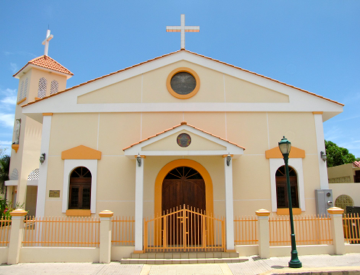
Patron:
Inmaculada Concepción de María
Inmaculada Concepción Parish
Calle Lebrum # 442
Vieques P.R. 00765
(787) 741-2241
Topography:
Vieques’ terrain is level to a large extent. Its highest elevation is mount Pirata, towards the west, with 301 meters.
Hydrography:
It consists of several lagoons.
Economy:
Tourism, manufacture and fishing.
Average Salary:
$257.13 weekly (1998)
Flag:
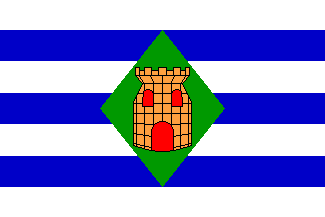 The flag of Vieques consists of seven horizontal straight stripes of equal width, four white and three blue alternated. In the center it has a green rhombus, in yellow color, a simplified design of the castle. The representation of Naval Crown is omitted.
The flag of Vieques consists of seven horizontal straight stripes of equal width, four white and three blue alternated. In the center it has a green rhombus, in yellow color, a simplified design of the castle. The representation of Naval Crown is omitted.
Coat Of Arms:
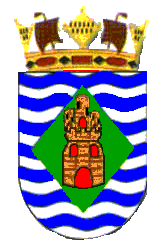 In a field of 10 waves, five silver-plated and five blue, a green rhombus with a gold castle outlined in black and red openings. To the top, a Naval crown in gold, with silver candles. The sea of Vieques is represented by the silver-plated and blue waves; the island, by the green rhombus; and the historical fort that dominates it, by the traditional Spanish heraldic castle. This castle, is also symbol of Spain, who took away the Island of Vieques from the Caribes, defended it from privateers of different nationalities, and later on, in the XIX century, incorporated the Island in a formal and definitive way, to Puerto Rico.
In a field of 10 waves, five silver-plated and five blue, a green rhombus with a gold castle outlined in black and red openings. To the top, a Naval crown in gold, with silver candles. The sea of Vieques is represented by the silver-plated and blue waves; the island, by the green rhombus; and the historical fort that dominates it, by the traditional Spanish heraldic castle. This castle, is also symbol of Spain, who took away the Island of Vieques from the Caribes, defended it from privateers of different nationalities, and later on, in the XIX century, incorporated the Island in a formal and definitive way, to Puerto Rico.
The gold color of the castle and the green of the rhombus, combined, have a special historical meaning. The main colors constitute the main colors of the shield of the Bolivars from Venezuela, proclaiming that this Island was the only Puerto Rican land that the liberator Simón Bolívar set foot on. Instead of the traditional crown, a Naval crown is adopted for the Coat of Arms of Vieques, to emphasize the insular nature of Vieques and to remember the glorious Naval encounters in its waters repelling the enemies of Spain and Puerto Rico.
Places To Visit:
- Conde de Mirasol Fort
- Mosquito Bay – bioluminescent bay
- Mulas Point Lighthouse
- Ferro Point archaeological zone
- Esperanza waterfront and monument to Angel Rodríguez Cristóbal
- Bust of Simón Bolívar, Isabel II Plaza
- Centennial Ceiba tree
- Tombs of the Le Guillou family
Events:
- Patron Saint Festival in honor of the Virgen del Carmen – July
- Three Kings Festival – January
Beaches:
- Punta Arenas Beach
- Punta Vaca Beach
- La Chiva Beach “Blue Beach”
- Sun Bay Beach
- Media Luna Beach
- Blanca Beach
- Esperanza Beach
- Barracuda Beach
- Punta Galíndez Beach
- Tapón (Hidden) Beach
- Pata Prieta “Secreat” Beach
- Caracas Beach (Red Beach)
- Navío Beach
- La Plata Beach
- Escondida Beach “Plateada Beach”
- Gallito Beach
- Tapón Beach
- Cofi Beach
- Puerto del Ferry
- Playuela Beach
- Black Sand Beach
- Airport Beach
- Mosquito Bay “Bioluminescent Bay”
- Grande Beach
- Cayo de Tierra
- Rompeolas / Mosquito Pier
Distinguished Citizens:
- Jaime Benítez – Educator and politician. Served as chancellor and president of the University of Puerto Rico from 1942 to 1972 and as resident commissioner in Washington from 1973 to 1976.
- Luisa Guadalupe – Community leader who fought for social and political causes on Vieques.
- Germán Rieckehoff Sampayo – Served as president of the Puerto Rico Olympic Committee.
- Carmelo Rodríguez Torres – University professor, novelist, essayist. His works include the novel Veinte siglos después del homicidio (1972), La casa y la llama fiera, Cinco cuentos negros, and others.
Public Schools sorted by educational levels.
Vieques District
| Name | Level | Telephone | Address |
| DR. JOSÉ CELSO BARBOSA | Elementary | (787) 741-0428 | PO Box 1175 |
| FRANKLIN D. ROOSEVELT | Elementary | (787) 741-2629 | PO Box 708 |
| JUANITA RIVERA ALBERT | Elementary | (787) 741-3060 | PO Box 1175 |
| MARÍA M. SIMMONS DE RIVERA | Elementary | (787) 741-3831 | PO Box 1518 |
| MERCEDES LUIS | Elementary | (787) 741-1099 | PO Box 708 |
| MONTE SANTO | Elementary | (787) 741-2899 | PO Box 708 |
| PLAYA GRANDE | Elementary | (787) 741-2766 | PO Box 708 |
| 20 DE SEPTIEMBRE DE 1988 | Intermediate | (787) 741-2802 | PO Box 1554 |
| ADRIANNE SERRANO | Second Unit | (787) 741-8692 | PO Box 1175 |
| GERMAN RIECKEHOFF | High School | (787) 741-8340 | PO Box 857 |
Hymn:
Author: Silverio Pérez
Hay una Isla Nena en lontanaza,
que es como Isla Grande en carne viva
Hay cantos de pitirre en La Esperanza
y hay deseos de amar y dar la vida.
Quietud interrumpida a cada instante,
niños despiertos en la madrugada,
el sol va despertando por el este
y en la tibia mañana se oye una nana.
Hay miles de pedazos de esta tierra,
con miles de ocasiones de injusticia
hay una isla chica que en la guerra,
roba tiempo al amor y a la caricia.
Un día que mi canción se hizo oleaje,
un día, que reposé en la blanca arena,
el di mi corazón y mi coraje,
al pueblo y al sentir de la Isla Nena.
Hay una Isla Nena en lontananza

